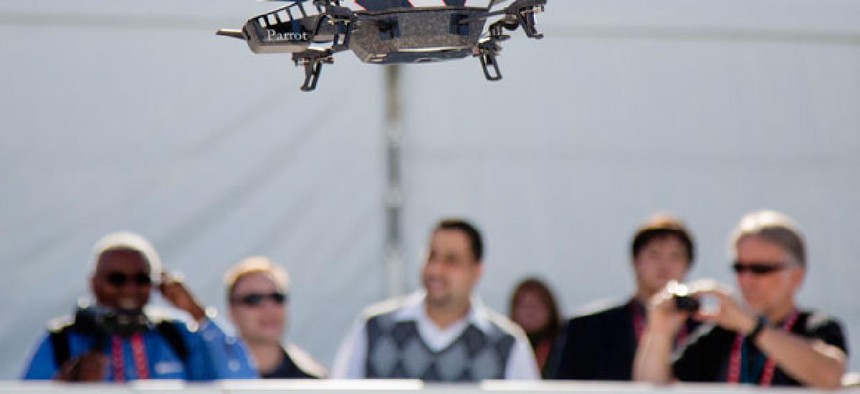The Wonderful World of Drones

A Parrot AR Drone 2.0 was exhibited at the Consumer Electronics Show in January. Julie Jacobson/AP
Fighting fires, reducing crime, counting sea lions - the case for domestic UAVs.
When Jimmy Lee Dykes held a 5-year-old captive in an Alabama bunker, a drone was monitoring from overhead. The 65-year-old had snatched the child from a school bus after killing the driver. As the hostage standoff dominated cable-news coverage for days in early February, authorities used the drone to scan the crime scene nearly continuously until they moved in and returned the child to safety.
Although privacy advocates worry about the use of unmanned aircraft, fearing they will be deployed to spy on Americans, some uses and applications could make drones invaluable.
As in Alabama, the flying robots, less obtrusive and able to stay aloft for longer than a piloted plane, can help with law enforcement. Equipped with facial-recognition and thermal-imaging capabilities, they can track criminals. Drones can monitor chemical hazards; detect explosives and detonate bombs; help firefighters wade into blazes and plan escape routes; and patrol U.S. borders. Farmers want to use them to spray for pests and check for signs of drought and blight. Drones are cost-efficient tools for scientific research: The University of Alaska uses the quiet aircraft to study sea lions; NASA sends them 65,000 feet above the Pacific Ocean for atmospheric research.
Congress directed the Federal Aviation Administration to make it safe for drones to fly domestically by 2015. The agency expects some 10,000 commercial drones (think news outlets and private businesses) to fly by 2017. And all 18,000 state and local law-enforcement agencies will be potential customers.
But the public’s suspicions about drones could stifle their positive potential. Lawmakers in 30 states are seeking to restrict or require warrants for their use. And the leaked Justice Department memo justifying the targeted killing of American terrorism suspects in far-off countries raised concerns that armed drones might eventually take out citizens on U.S. soil.
Washington’s drone lobby is not happy. “We’ve come to recognize that ‘drone’ is a pejorative term,” says Mario Mairena of the Association for Unmanned Vehicle Systems International, which has more than 600 corporate members, including Northrop Grumman and Raytheon. “People picture the unmanned aircraft systems that are used in-theater, and that scares people, because all they see are these images of [the aircraft] used with missiles.” Mairena laments that media outlets often illustrate their stories about domestic drones with pictures of Predator aircraft, while the FAA is working to expedite permits for much smaller robots (under 25 pounds).
To sooth a skeptical public, his association launched a website, IncreasingHumanPotential.org. “Folks are fearful of what they don’t know,” Mairena says. “We want to set the debate on proper footing by recognizing there are a great deal of benefits.” The United States sent drones to Japan after the tsunami because it was too hazardous for humans to monitor the Fukushima nuclear plant, Mairena says, and the robots were used to help with search-and-rescue efforts after Hurricane Katrina.
Greg McNeal, a professor at Pepperdine University, says some manufacturers have discussed using drones as a first-responder system for 911 emergency calls, immediately deploying them to gather visual information such as whether the trouble is a four-alarm fire or a minor blaze. “By grounding these systems before they can ever be launched,” he says, “we might not ever be able to develop these new and innovative ways of protecting people’s lives.”
The drone technology also presents potential economic benefits. About 30 states are looking to host one of the FAA’s six proposed test sites, because they will attract business. In the first three years after drones are integrated into the national airspace, AUVSI predicts, they will create more than 70,000 jobs. The FAA estimates the industry could grow to $90 billion over the next decade. The drones will need operators; businesses will need to invest research-and-development funds; the supply chain will rev up production to meet the growing demand.
Even the American Civil Liberties Union is “not against the use of drones—far from it,” staff lawyer Catherine Crump says. She emphasizes that the ACLU simply wants authorities to abstain from using them for investigations unless they have reasonable suspicion they will turn up a specific criminal act. A Monmouth University poll in June found that two-thirds of Americans are “very concerned” or “somewhat concerned” about their privacy if law-enforcement agencies use drones with high-tech cameras.
But McNeal says drones have the potential to be even more protective of individual rights than manned aircraft. If a helicopter surveys land where someone is suspected of growing marijuana, for instance, the pilot will view other properties on the way—or, say, neighbors sunbathing. But technology exists to instruct the drone to observe only the marijuana and ignore other data, he says. Creating local boards to review information that police collect with drones could also prevent a scenario in which authorities “selectively delete [information] in a way that benefits them.” Or simply publishing drones’ flight paths, McNeal says, would enable “privacy advocates to know what their governments are doing and the police department to show they’re not abusing the system.”
After public pressure, the FAA—which maintains it is responsible only for the safety of U.S. airspace—is soliciting comments for a privacy policy at test-site locations. In a preview of problems that drones could present without proper regulations, the agency is investigating a pilot’s report of observing an unidentified drone this week while approaching New York’s John F. Kennedy Airport.
For the aircraft to get a fair chance for use domestically, says Gerald Dillingham, director of civil-aviation issues for the Government Accountability Office, individual rights must be addressed now. “We think there needs to be some kind of public involvement, public education—and the public will be more likely to embrace this kind of technology if they feel their privacy is being looked after.”
NEXT STORY: Feds seek user input on mobile experience


